Partnership Working in Further Education: Models, Impact & Resources
VerifiedAdded on 2023/06/04
|10
|3096
|87
Report
AI Summary
This report explores effective partnership working within the learning and teaching context of further education. It discusses various partnership models, including public-private partnerships, product development partnerships, and public-social-private partnerships, highlighting the opportunities and challenges associated with each. Opportunities include increased knowledge and skills, flexibility, and resource availability, while challenges involve employee diversity, organizational compatibility, and boundary setting. The report also examines how to sustain partnerships by focusing on staff training, objective adherence, and effective marketing. Furthermore, it summarizes the impact of key government policies and initiatives on partnerships, such as curriculum updates, economic and political considerations, and fee structure design. Finally, the report addresses resource implications, the need for realistic timescales and deadlines, and the importance of ground rules and terms of reference for effective partnership working. Desklib provides solved assignments for students.
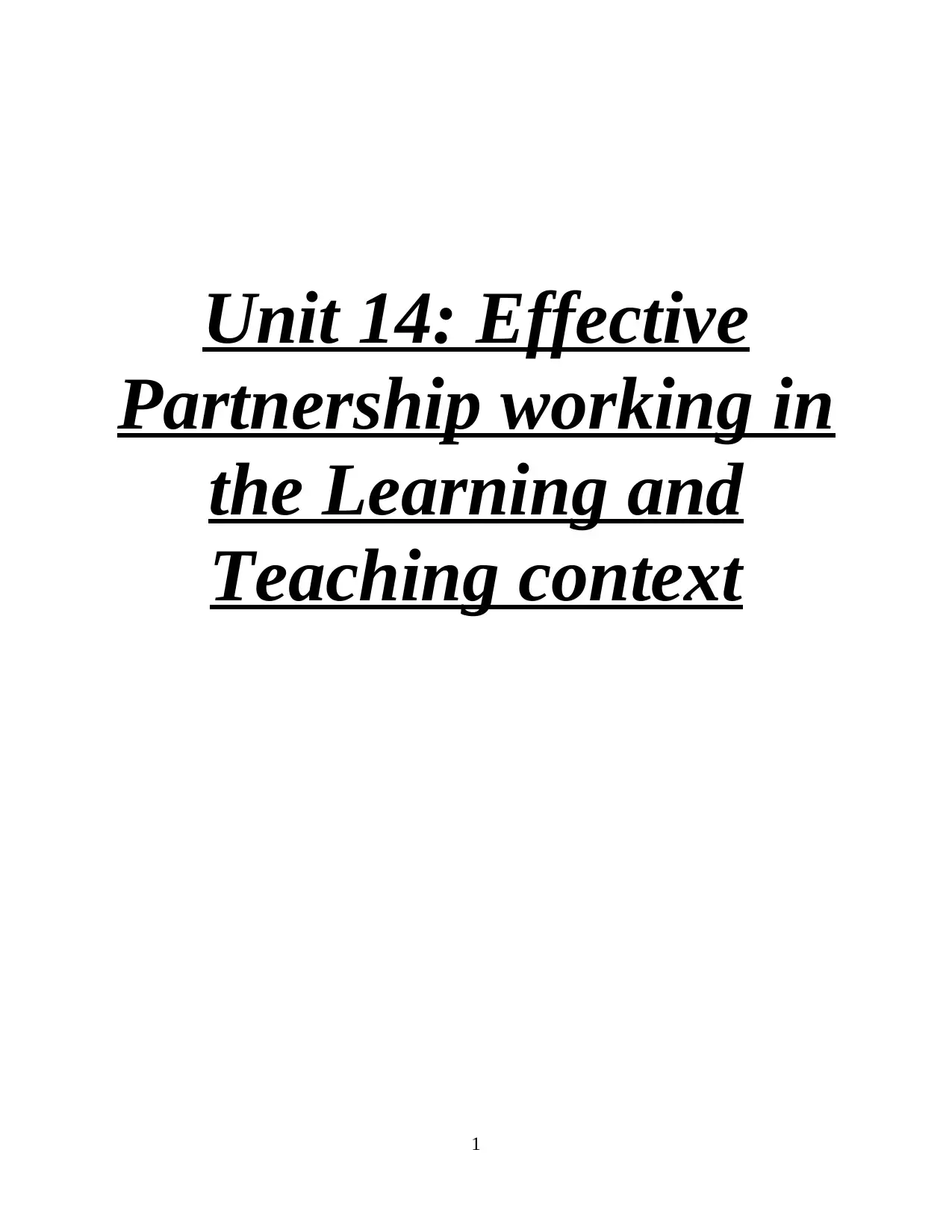
Unit 14: Effective
Partnership working in
the Learning and
Teaching context
1
Partnership working in
the Learning and
Teaching context
1
Paraphrase This Document
Need a fresh take? Get an instant paraphrase of this document with our AI Paraphraser
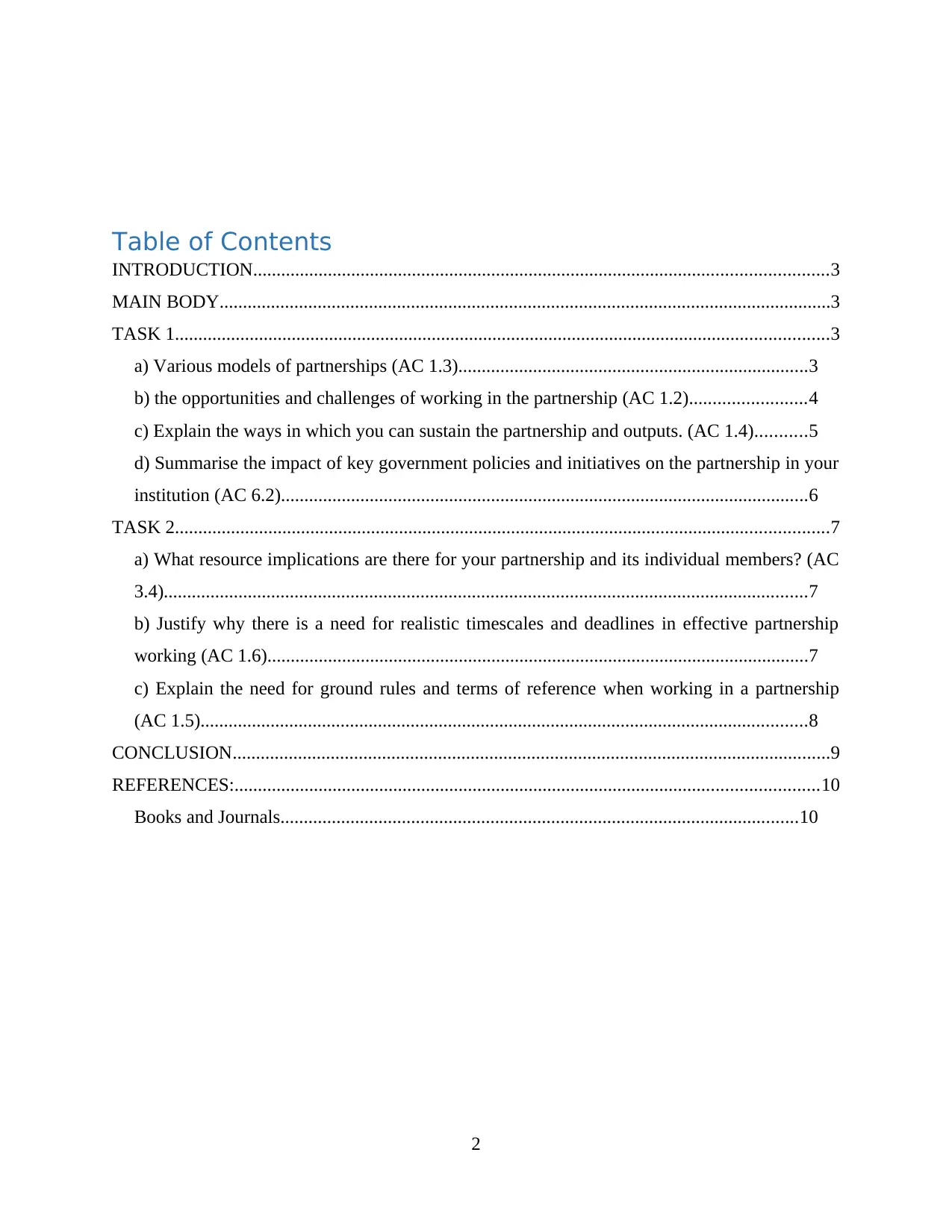
Table of Contents
INTRODUCTION...........................................................................................................................3
MAIN BODY...................................................................................................................................3
TASK 1............................................................................................................................................3
a) Various models of partnerships (AC 1.3)...........................................................................3
b) the opportunities and challenges of working in the partnership (AC 1.2).........................4
c) Explain the ways in which you can sustain the partnership and outputs. (AC 1.4)...........5
d) Summarise the impact of key government policies and initiatives on the partnership in your
institution (AC 6.2).................................................................................................................6
TASK 2............................................................................................................................................7
a) What resource implications are there for your partnership and its individual members? (AC
3.4)..........................................................................................................................................7
b) Justify why there is a need for realistic timescales and deadlines in effective partnership
working (AC 1.6)....................................................................................................................7
c) Explain the need for ground rules and terms of reference when working in a partnership
(AC 1.5)..................................................................................................................................8
CONCLUSION................................................................................................................................9
REFERENCES:.............................................................................................................................10
Books and Journals...............................................................................................................10
2
INTRODUCTION...........................................................................................................................3
MAIN BODY...................................................................................................................................3
TASK 1............................................................................................................................................3
a) Various models of partnerships (AC 1.3)...........................................................................3
b) the opportunities and challenges of working in the partnership (AC 1.2).........................4
c) Explain the ways in which you can sustain the partnership and outputs. (AC 1.4)...........5
d) Summarise the impact of key government policies and initiatives on the partnership in your
institution (AC 6.2).................................................................................................................6
TASK 2............................................................................................................................................7
a) What resource implications are there for your partnership and its individual members? (AC
3.4)..........................................................................................................................................7
b) Justify why there is a need for realistic timescales and deadlines in effective partnership
working (AC 1.6)....................................................................................................................7
c) Explain the need for ground rules and terms of reference when working in a partnership
(AC 1.5)..................................................................................................................................8
CONCLUSION................................................................................................................................9
REFERENCES:.............................................................................................................................10
Books and Journals...............................................................................................................10
2
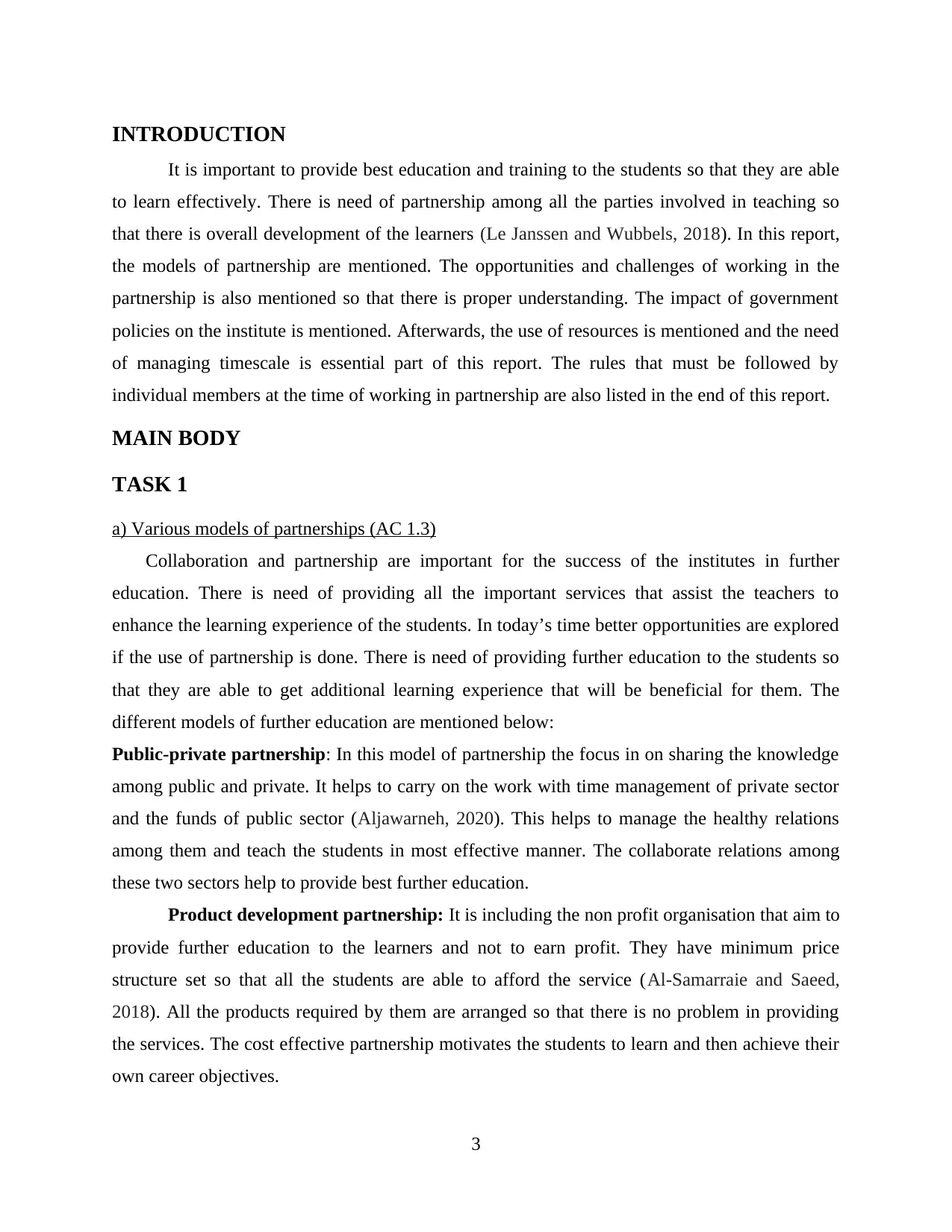
INTRODUCTION
It is important to provide best education and training to the students so that they are able
to learn effectively. There is need of partnership among all the parties involved in teaching so
that there is overall development of the learners (Le Janssen and Wubbels, 2018). In this report,
the models of partnership are mentioned. The opportunities and challenges of working in the
partnership is also mentioned so that there is proper understanding. The impact of government
policies on the institute is mentioned. Afterwards, the use of resources is mentioned and the need
of managing timescale is essential part of this report. The rules that must be followed by
individual members at the time of working in partnership are also listed in the end of this report.
MAIN BODY
TASK 1
a) Various models of partnerships (AC 1.3)
Collaboration and partnership are important for the success of the institutes in further
education. There is need of providing all the important services that assist the teachers to
enhance the learning experience of the students. In today’s time better opportunities are explored
if the use of partnership is done. There is need of providing further education to the students so
that they are able to get additional learning experience that will be beneficial for them. The
different models of further education are mentioned below:
Public-private partnership: In this model of partnership the focus in on sharing the knowledge
among public and private. It helps to carry on the work with time management of private sector
and the funds of public sector (Aljawarneh, 2020). This helps to manage the healthy relations
among them and teach the students in most effective manner. The collaborate relations among
these two sectors help to provide best further education.
Product development partnership: It is including the non profit organisation that aim to
provide further education to the learners and not to earn profit. They have minimum price
structure set so that all the students are able to afford the service (Al-Samarraie and Saeed,
2018). All the products required by them are arranged so that there is no problem in providing
the services. The cost effective partnership motivates the students to learn and then achieve their
own career objectives.
3
It is important to provide best education and training to the students so that they are able
to learn effectively. There is need of partnership among all the parties involved in teaching so
that there is overall development of the learners (Le Janssen and Wubbels, 2018). In this report,
the models of partnership are mentioned. The opportunities and challenges of working in the
partnership is also mentioned so that there is proper understanding. The impact of government
policies on the institute is mentioned. Afterwards, the use of resources is mentioned and the need
of managing timescale is essential part of this report. The rules that must be followed by
individual members at the time of working in partnership are also listed in the end of this report.
MAIN BODY
TASK 1
a) Various models of partnerships (AC 1.3)
Collaboration and partnership are important for the success of the institutes in further
education. There is need of providing all the important services that assist the teachers to
enhance the learning experience of the students. In today’s time better opportunities are explored
if the use of partnership is done. There is need of providing further education to the students so
that they are able to get additional learning experience that will be beneficial for them. The
different models of further education are mentioned below:
Public-private partnership: In this model of partnership the focus in on sharing the knowledge
among public and private. It helps to carry on the work with time management of private sector
and the funds of public sector (Aljawarneh, 2020). This helps to manage the healthy relations
among them and teach the students in most effective manner. The collaborate relations among
these two sectors help to provide best further education.
Product development partnership: It is including the non profit organisation that aim to
provide further education to the learners and not to earn profit. They have minimum price
structure set so that all the students are able to afford the service (Al-Samarraie and Saeed,
2018). All the products required by them are arranged so that there is no problem in providing
the services. The cost effective partnership motivates the students to learn and then achieve their
own career objectives.
3
⊘ This is a preview!⊘
Do you want full access?
Subscribe today to unlock all pages.

Trusted by 1+ million students worldwide
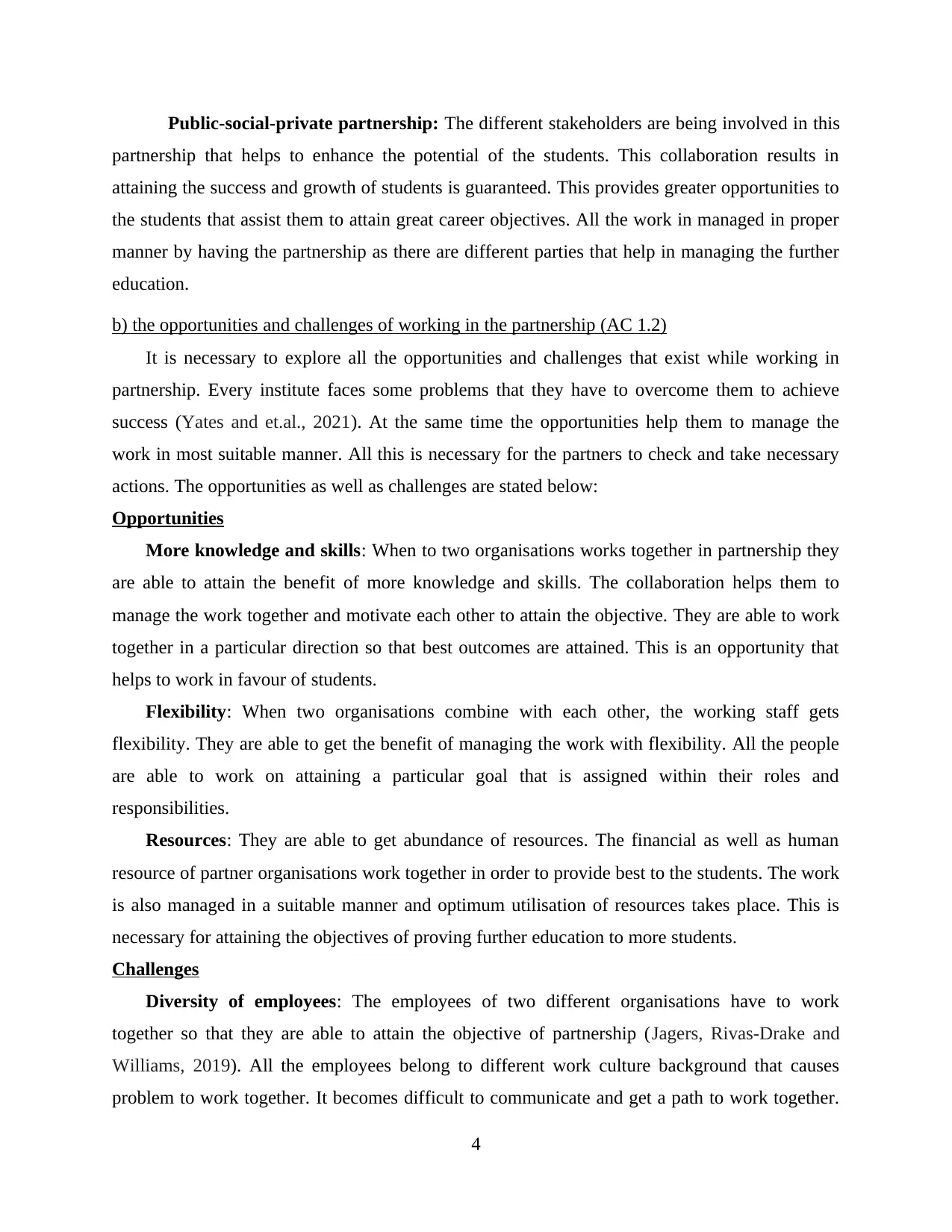
Public-social-private partnership: The different stakeholders are being involved in this
partnership that helps to enhance the potential of the students. This collaboration results in
attaining the success and growth of students is guaranteed. This provides greater opportunities to
the students that assist them to attain great career objectives. All the work in managed in proper
manner by having the partnership as there are different parties that help in managing the further
education.
b) the opportunities and challenges of working in the partnership (AC 1.2)
It is necessary to explore all the opportunities and challenges that exist while working in
partnership. Every institute faces some problems that they have to overcome them to achieve
success (Yates and et.al., 2021). At the same time the opportunities help them to manage the
work in most suitable manner. All this is necessary for the partners to check and take necessary
actions. The opportunities as well as challenges are stated below:
Opportunities
More knowledge and skills: When to two organisations works together in partnership they
are able to attain the benefit of more knowledge and skills. The collaboration helps them to
manage the work together and motivate each other to attain the objective. They are able to work
together in a particular direction so that best outcomes are attained. This is an opportunity that
helps to work in favour of students.
Flexibility: When two organisations combine with each other, the working staff gets
flexibility. They are able to get the benefit of managing the work with flexibility. All the people
are able to work on attaining a particular goal that is assigned within their roles and
responsibilities.
Resources: They are able to get abundance of resources. The financial as well as human
resource of partner organisations work together in order to provide best to the students. The work
is also managed in a suitable manner and optimum utilisation of resources takes place. This is
necessary for attaining the objectives of proving further education to more students.
Challenges
Diversity of employees: The employees of two different organisations have to work
together so that they are able to attain the objective of partnership (Jagers, Rivas-Drake and
Williams, 2019). All the employees belong to different work culture background that causes
problem to work together. It becomes difficult to communicate and get a path to work together.
4
partnership that helps to enhance the potential of the students. This collaboration results in
attaining the success and growth of students is guaranteed. This provides greater opportunities to
the students that assist them to attain great career objectives. All the work in managed in proper
manner by having the partnership as there are different parties that help in managing the further
education.
b) the opportunities and challenges of working in the partnership (AC 1.2)
It is necessary to explore all the opportunities and challenges that exist while working in
partnership. Every institute faces some problems that they have to overcome them to achieve
success (Yates and et.al., 2021). At the same time the opportunities help them to manage the
work in most suitable manner. All this is necessary for the partners to check and take necessary
actions. The opportunities as well as challenges are stated below:
Opportunities
More knowledge and skills: When to two organisations works together in partnership they
are able to attain the benefit of more knowledge and skills. The collaboration helps them to
manage the work together and motivate each other to attain the objective. They are able to work
together in a particular direction so that best outcomes are attained. This is an opportunity that
helps to work in favour of students.
Flexibility: When two organisations combine with each other, the working staff gets
flexibility. They are able to get the benefit of managing the work with flexibility. All the people
are able to work on attaining a particular goal that is assigned within their roles and
responsibilities.
Resources: They are able to get abundance of resources. The financial as well as human
resource of partner organisations work together in order to provide best to the students. The work
is also managed in a suitable manner and optimum utilisation of resources takes place. This is
necessary for attaining the objectives of proving further education to more students.
Challenges
Diversity of employees: The employees of two different organisations have to work
together so that they are able to attain the objective of partnership (Jagers, Rivas-Drake and
Williams, 2019). All the employees belong to different work culture background that causes
problem to work together. It becomes difficult to communicate and get a path to work together.
4
Paraphrase This Document
Need a fresh take? Get an instant paraphrase of this document with our AI Paraphraser
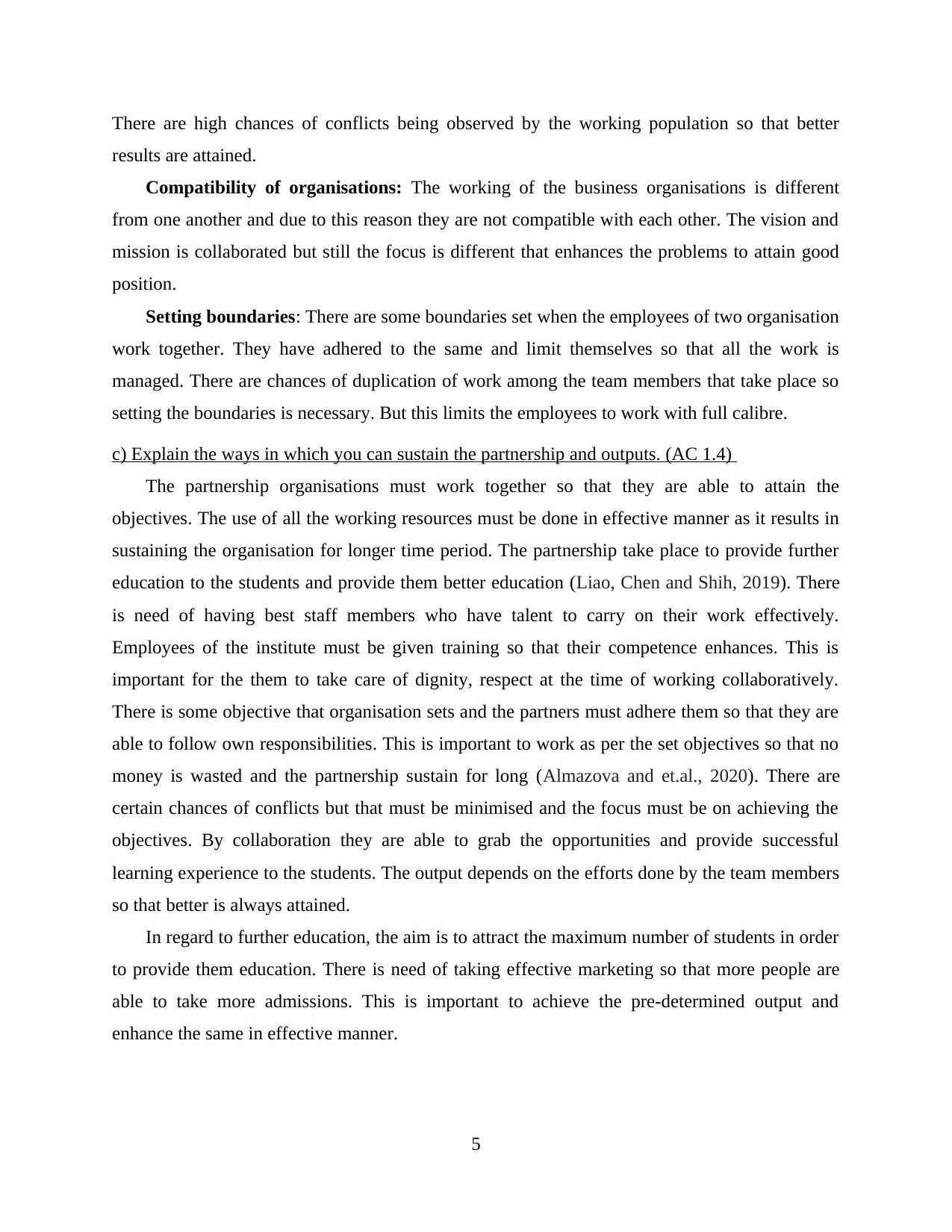
There are high chances of conflicts being observed by the working population so that better
results are attained.
Compatibility of organisations: The working of the business organisations is different
from one another and due to this reason they are not compatible with each other. The vision and
mission is collaborated but still the focus is different that enhances the problems to attain good
position.
Setting boundaries: There are some boundaries set when the employees of two organisation
work together. They have adhered to the same and limit themselves so that all the work is
managed. There are chances of duplication of work among the team members that take place so
setting the boundaries is necessary. But this limits the employees to work with full calibre.
c) Explain the ways in which you can sustain the partnership and outputs. (AC 1.4)
The partnership organisations must work together so that they are able to attain the
objectives. The use of all the working resources must be done in effective manner as it results in
sustaining the organisation for longer time period. The partnership take place to provide further
education to the students and provide them better education (Liao, Chen and Shih, 2019). There
is need of having best staff members who have talent to carry on their work effectively.
Employees of the institute must be given training so that their competence enhances. This is
important for the them to take care of dignity, respect at the time of working collaboratively.
There is some objective that organisation sets and the partners must adhere them so that they are
able to follow own responsibilities. This is important to work as per the set objectives so that no
money is wasted and the partnership sustain for long (Almazova and et.al., 2020). There are
certain chances of conflicts but that must be minimised and the focus must be on achieving the
objectives. By collaboration they are able to grab the opportunities and provide successful
learning experience to the students. The output depends on the efforts done by the team members
so that better is always attained.
In regard to further education, the aim is to attract the maximum number of students in order
to provide them education. There is need of taking effective marketing so that more people are
able to take more admissions. This is important to achieve the pre-determined output and
enhance the same in effective manner.
5
results are attained.
Compatibility of organisations: The working of the business organisations is different
from one another and due to this reason they are not compatible with each other. The vision and
mission is collaborated but still the focus is different that enhances the problems to attain good
position.
Setting boundaries: There are some boundaries set when the employees of two organisation
work together. They have adhered to the same and limit themselves so that all the work is
managed. There are chances of duplication of work among the team members that take place so
setting the boundaries is necessary. But this limits the employees to work with full calibre.
c) Explain the ways in which you can sustain the partnership and outputs. (AC 1.4)
The partnership organisations must work together so that they are able to attain the
objectives. The use of all the working resources must be done in effective manner as it results in
sustaining the organisation for longer time period. The partnership take place to provide further
education to the students and provide them better education (Liao, Chen and Shih, 2019). There
is need of having best staff members who have talent to carry on their work effectively.
Employees of the institute must be given training so that their competence enhances. This is
important for the them to take care of dignity, respect at the time of working collaboratively.
There is some objective that organisation sets and the partners must adhere them so that they are
able to follow own responsibilities. This is important to work as per the set objectives so that no
money is wasted and the partnership sustain for long (Almazova and et.al., 2020). There are
certain chances of conflicts but that must be minimised and the focus must be on achieving the
objectives. By collaboration they are able to grab the opportunities and provide successful
learning experience to the students. The output depends on the efforts done by the team members
so that better is always attained.
In regard to further education, the aim is to attract the maximum number of students in order
to provide them education. There is need of taking effective marketing so that more people are
able to take more admissions. This is important to achieve the pre-determined output and
enhance the same in effective manner.
5
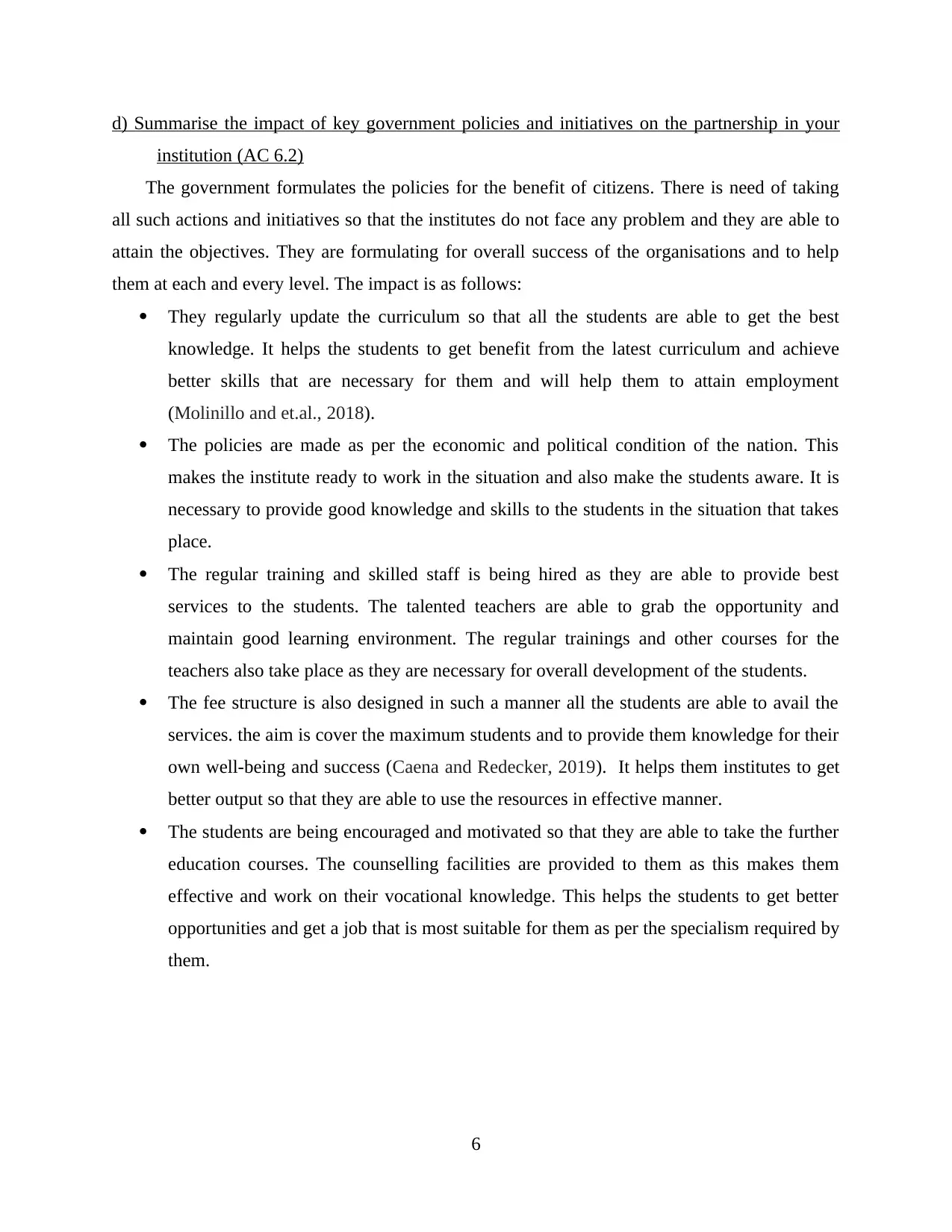
d) Summarise the impact of key government policies and initiatives on the partnership in your
institution (AC 6.2)
The government formulates the policies for the benefit of citizens. There is need of taking
all such actions and initiatives so that the institutes do not face any problem and they are able to
attain the objectives. They are formulating for overall success of the organisations and to help
them at each and every level. The impact is as follows:
They regularly update the curriculum so that all the students are able to get the best
knowledge. It helps the students to get benefit from the latest curriculum and achieve
better skills that are necessary for them and will help them to attain employment
(Molinillo and et.al., 2018).
The policies are made as per the economic and political condition of the nation. This
makes the institute ready to work in the situation and also make the students aware. It is
necessary to provide good knowledge and skills to the students in the situation that takes
place.
The regular training and skilled staff is being hired as they are able to provide best
services to the students. The talented teachers are able to grab the opportunity and
maintain good learning environment. The regular trainings and other courses for the
teachers also take place as they are necessary for overall development of the students.
The fee structure is also designed in such a manner all the students are able to avail the
services. the aim is cover the maximum students and to provide them knowledge for their
own well-being and success (Caena and Redecker, 2019). It helps them institutes to get
better output so that they are able to use the resources in effective manner.
The students are being encouraged and motivated so that they are able to take the further
education courses. The counselling facilities are provided to them as this makes them
effective and work on their vocational knowledge. This helps the students to get better
opportunities and get a job that is most suitable for them as per the specialism required by
them.
6
institution (AC 6.2)
The government formulates the policies for the benefit of citizens. There is need of taking
all such actions and initiatives so that the institutes do not face any problem and they are able to
attain the objectives. They are formulating for overall success of the organisations and to help
them at each and every level. The impact is as follows:
They regularly update the curriculum so that all the students are able to get the best
knowledge. It helps the students to get benefit from the latest curriculum and achieve
better skills that are necessary for them and will help them to attain employment
(Molinillo and et.al., 2018).
The policies are made as per the economic and political condition of the nation. This
makes the institute ready to work in the situation and also make the students aware. It is
necessary to provide good knowledge and skills to the students in the situation that takes
place.
The regular training and skilled staff is being hired as they are able to provide best
services to the students. The talented teachers are able to grab the opportunity and
maintain good learning environment. The regular trainings and other courses for the
teachers also take place as they are necessary for overall development of the students.
The fee structure is also designed in such a manner all the students are able to avail the
services. the aim is cover the maximum students and to provide them knowledge for their
own well-being and success (Caena and Redecker, 2019). It helps them institutes to get
better output so that they are able to use the resources in effective manner.
The students are being encouraged and motivated so that they are able to take the further
education courses. The counselling facilities are provided to them as this makes them
effective and work on their vocational knowledge. This helps the students to get better
opportunities and get a job that is most suitable for them as per the specialism required by
them.
6
⊘ This is a preview!⊘
Do you want full access?
Subscribe today to unlock all pages.

Trusted by 1+ million students worldwide
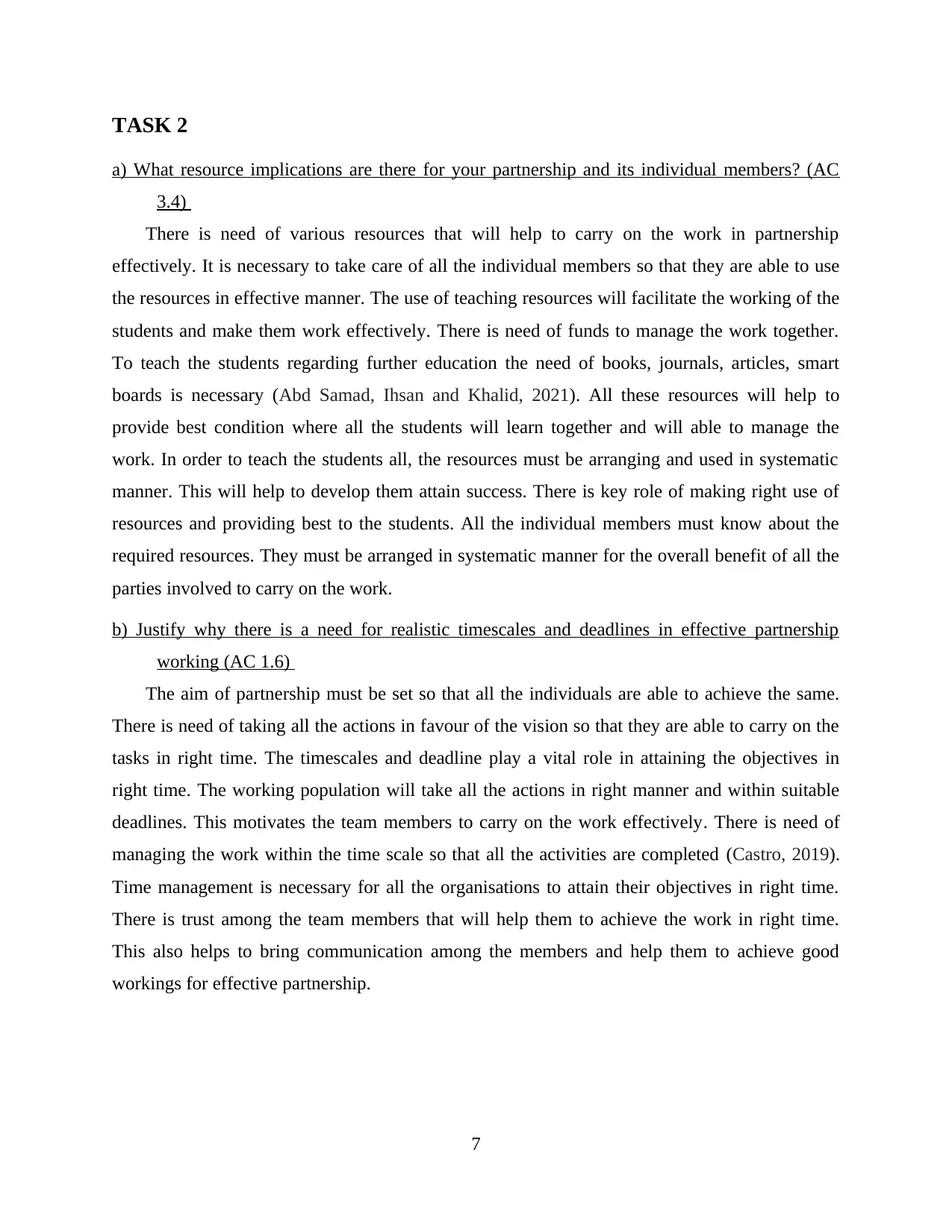
TASK 2
a) What resource implications are there for your partnership and its individual members? (AC
3.4)
There is need of various resources that will help to carry on the work in partnership
effectively. It is necessary to take care of all the individual members so that they are able to use
the resources in effective manner. The use of teaching resources will facilitate the working of the
students and make them work effectively. There is need of funds to manage the work together.
To teach the students regarding further education the need of books, journals, articles, smart
boards is necessary (Abd Samad, Ihsan and Khalid, 2021). All these resources will help to
provide best condition where all the students will learn together and will able to manage the
work. In order to teach the students all, the resources must be arranging and used in systematic
manner. This will help to develop them attain success. There is key role of making right use of
resources and providing best to the students. All the individual members must know about the
required resources. They must be arranged in systematic manner for the overall benefit of all the
parties involved to carry on the work.
b) Justify why there is a need for realistic timescales and deadlines in effective partnership
working (AC 1.6)
The aim of partnership must be set so that all the individuals are able to achieve the same.
There is need of taking all the actions in favour of the vision so that they are able to carry on the
tasks in right time. The timescales and deadline play a vital role in attaining the objectives in
right time. The working population will take all the actions in right manner and within suitable
deadlines. This motivates the team members to carry on the work effectively. There is need of
managing the work within the time scale so that all the activities are completed (Castro, 2019).
Time management is necessary for all the organisations to attain their objectives in right time.
There is trust among the team members that will help them to achieve the work in right time.
This also helps to bring communication among the members and help them to achieve good
workings for effective partnership.
7
a) What resource implications are there for your partnership and its individual members? (AC
3.4)
There is need of various resources that will help to carry on the work in partnership
effectively. It is necessary to take care of all the individual members so that they are able to use
the resources in effective manner. The use of teaching resources will facilitate the working of the
students and make them work effectively. There is need of funds to manage the work together.
To teach the students regarding further education the need of books, journals, articles, smart
boards is necessary (Abd Samad, Ihsan and Khalid, 2021). All these resources will help to
provide best condition where all the students will learn together and will able to manage the
work. In order to teach the students all, the resources must be arranging and used in systematic
manner. This will help to develop them attain success. There is key role of making right use of
resources and providing best to the students. All the individual members must know about the
required resources. They must be arranged in systematic manner for the overall benefit of all the
parties involved to carry on the work.
b) Justify why there is a need for realistic timescales and deadlines in effective partnership
working (AC 1.6)
The aim of partnership must be set so that all the individuals are able to achieve the same.
There is need of taking all the actions in favour of the vision so that they are able to carry on the
tasks in right time. The timescales and deadline play a vital role in attaining the objectives in
right time. The working population will take all the actions in right manner and within suitable
deadlines. This motivates the team members to carry on the work effectively. There is need of
managing the work within the time scale so that all the activities are completed (Castro, 2019).
Time management is necessary for all the organisations to attain their objectives in right time.
There is trust among the team members that will help them to achieve the work in right time.
This also helps to bring communication among the members and help them to achieve good
workings for effective partnership.
7
Paraphrase This Document
Need a fresh take? Get an instant paraphrase of this document with our AI Paraphraser
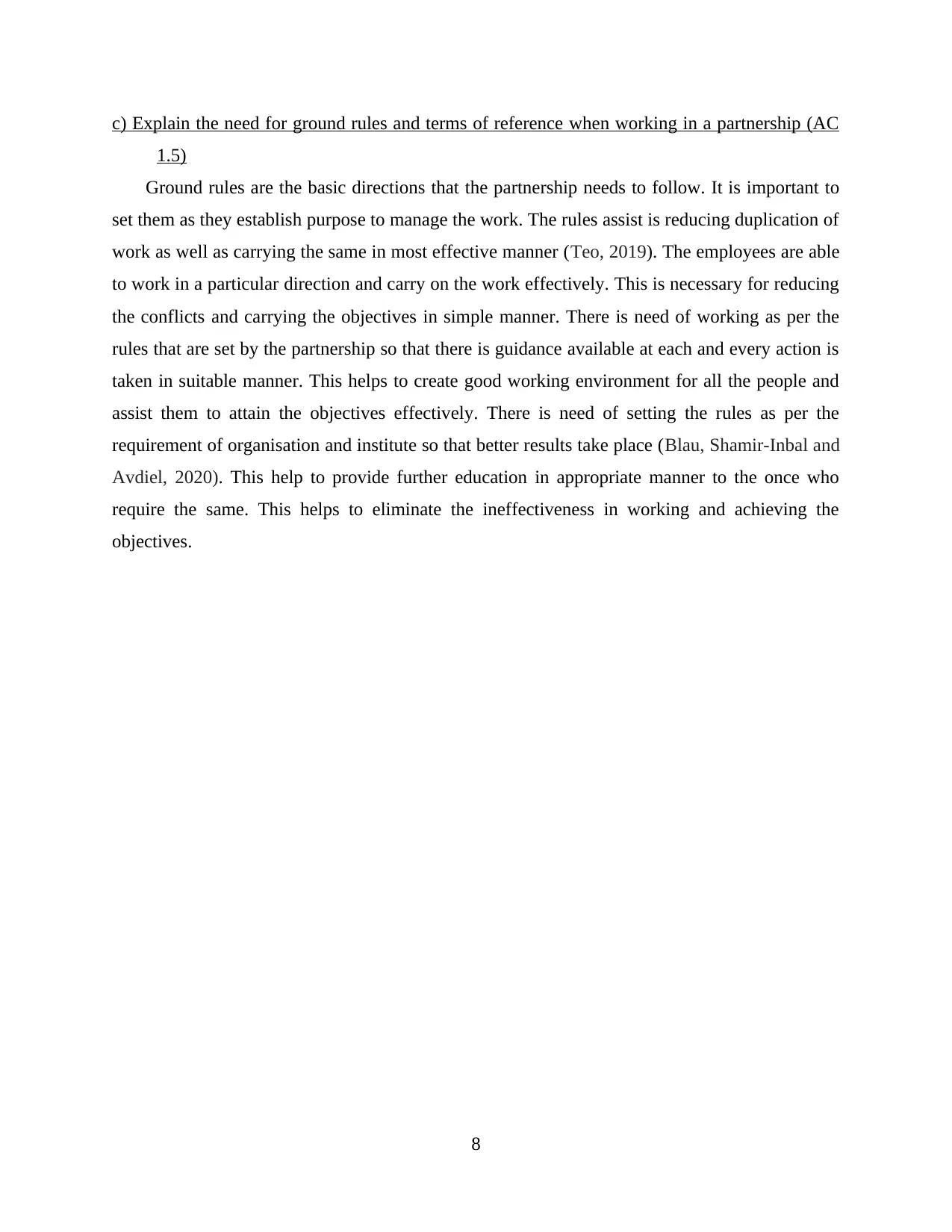
c) Explain the need for ground rules and terms of reference when working in a partnership (AC
1.5)
Ground rules are the basic directions that the partnership needs to follow. It is important to
set them as they establish purpose to manage the work. The rules assist is reducing duplication of
work as well as carrying the same in most effective manner (Teo, 2019). The employees are able
to work in a particular direction and carry on the work effectively. This is necessary for reducing
the conflicts and carrying the objectives in simple manner. There is need of working as per the
rules that are set by the partnership so that there is guidance available at each and every action is
taken in suitable manner. This helps to create good working environment for all the people and
assist them to attain the objectives effectively. There is need of setting the rules as per the
requirement of organisation and institute so that better results take place (Blau, Shamir-Inbal and
Avdiel, 2020). This help to provide further education in appropriate manner to the once who
require the same. This helps to eliminate the ineffectiveness in working and achieving the
objectives.
8
1.5)
Ground rules are the basic directions that the partnership needs to follow. It is important to
set them as they establish purpose to manage the work. The rules assist is reducing duplication of
work as well as carrying the same in most effective manner (Teo, 2019). The employees are able
to work in a particular direction and carry on the work effectively. This is necessary for reducing
the conflicts and carrying the objectives in simple manner. There is need of working as per the
rules that are set by the partnership so that there is guidance available at each and every action is
taken in suitable manner. This helps to create good working environment for all the people and
assist them to attain the objectives effectively. There is need of setting the rules as per the
requirement of organisation and institute so that better results take place (Blau, Shamir-Inbal and
Avdiel, 2020). This help to provide further education in appropriate manner to the once who
require the same. This helps to eliminate the ineffectiveness in working and achieving the
objectives.
8
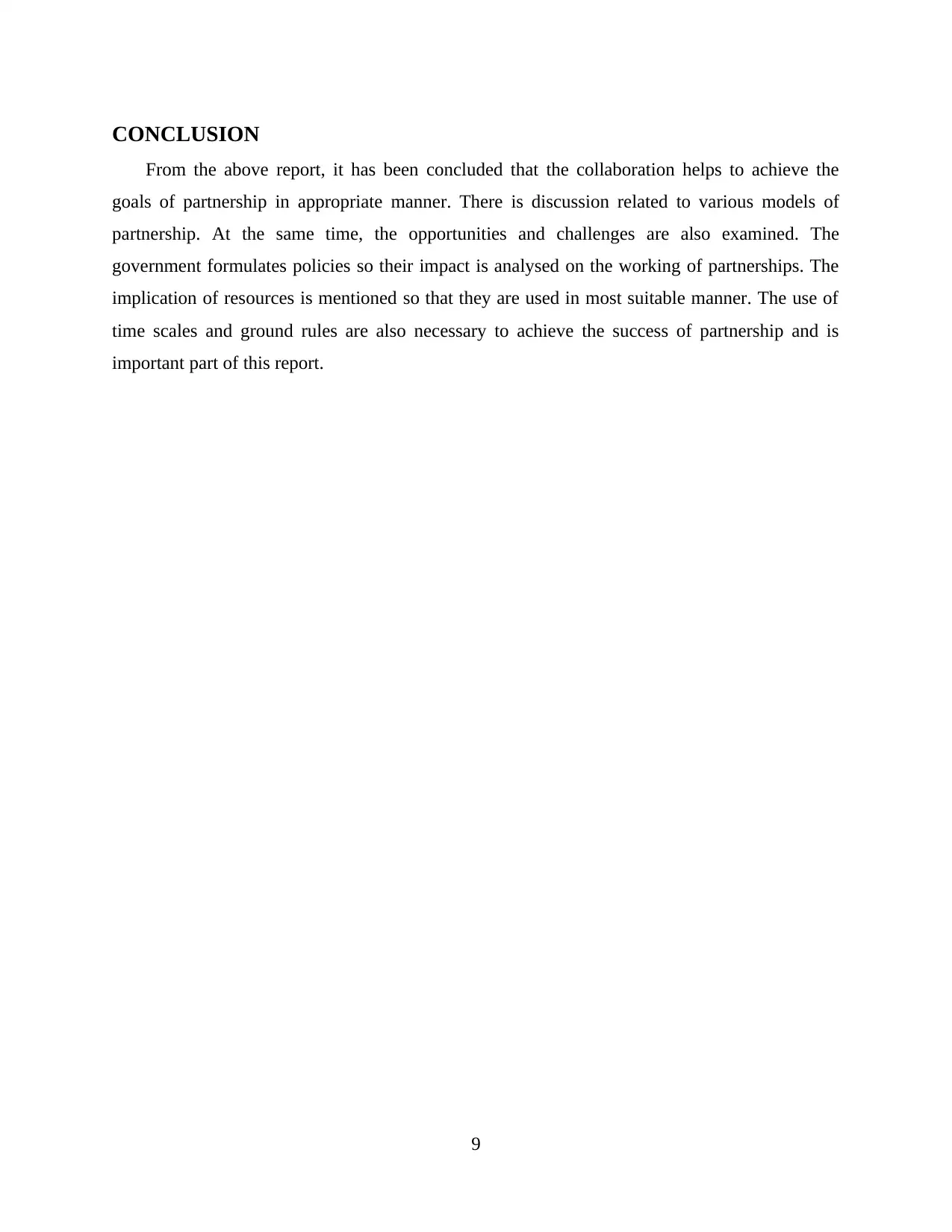
CONCLUSION
From the above report, it has been concluded that the collaboration helps to achieve the
goals of partnership in appropriate manner. There is discussion related to various models of
partnership. At the same time, the opportunities and challenges are also examined. The
government formulates policies so their impact is analysed on the working of partnerships. The
implication of resources is mentioned so that they are used in most suitable manner. The use of
time scales and ground rules are also necessary to achieve the success of partnership and is
important part of this report.
9
From the above report, it has been concluded that the collaboration helps to achieve the
goals of partnership in appropriate manner. There is discussion related to various models of
partnership. At the same time, the opportunities and challenges are also examined. The
government formulates policies so their impact is analysed on the working of partnerships. The
implication of resources is mentioned so that they are used in most suitable manner. The use of
time scales and ground rules are also necessary to achieve the success of partnership and is
important part of this report.
9
⊘ This is a preview!⊘
Do you want full access?
Subscribe today to unlock all pages.

Trusted by 1+ million students worldwide
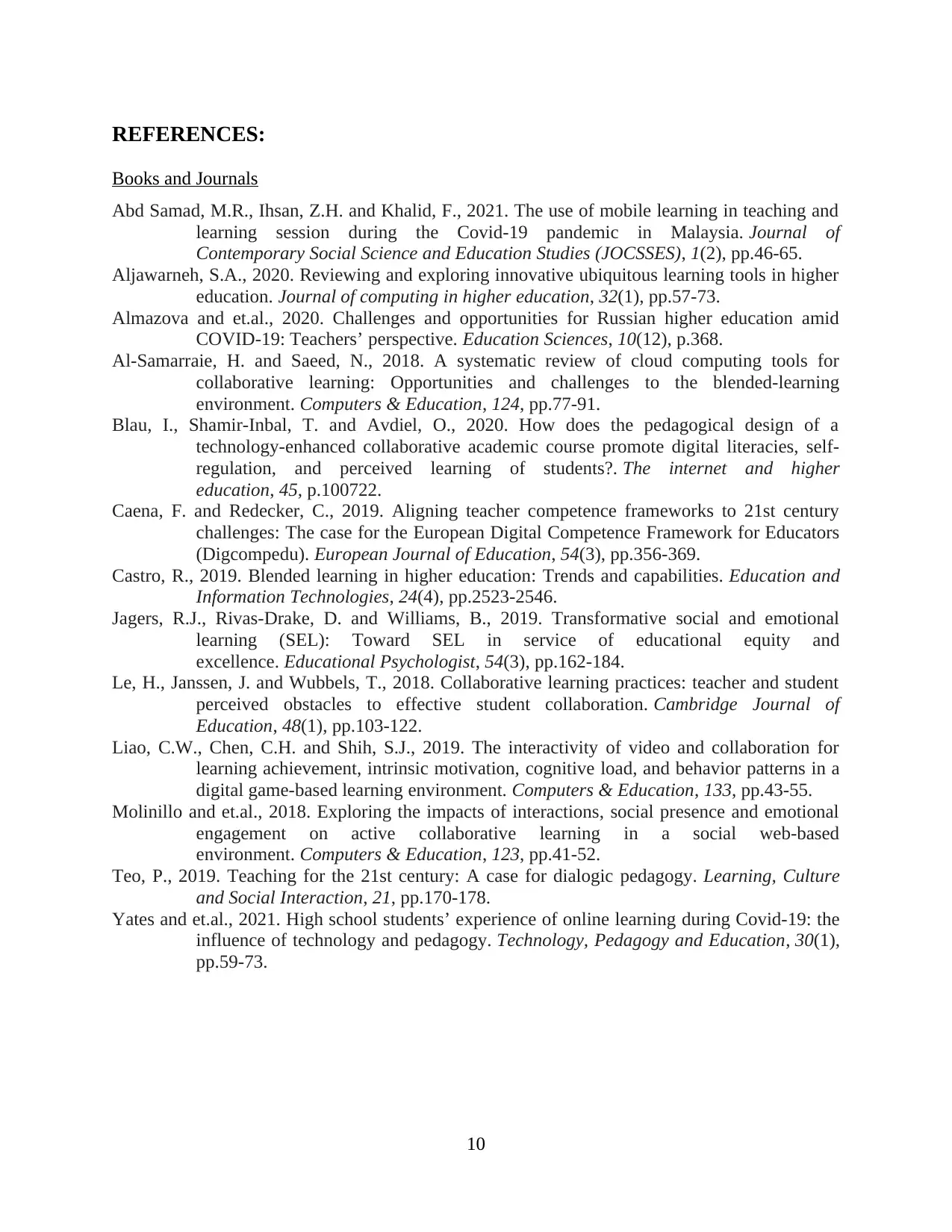
REFERENCES:
Books and Journals
Abd Samad, M.R., Ihsan, Z.H. and Khalid, F., 2021. The use of mobile learning in teaching and
learning session during the Covid-19 pandemic in Malaysia. Journal of
Contemporary Social Science and Education Studies (JOCSSES), 1(2), pp.46-65.
Aljawarneh, S.A., 2020. Reviewing and exploring innovative ubiquitous learning tools in higher
education. Journal of computing in higher education, 32(1), pp.57-73.
Almazova and et.al., 2020. Challenges and opportunities for Russian higher education amid
COVID-19: Teachers’ perspective. Education Sciences, 10(12), p.368.
Al-Samarraie, H. and Saeed, N., 2018. A systematic review of cloud computing tools for
collaborative learning: Opportunities and challenges to the blended-learning
environment. Computers & Education, 124, pp.77-91.
Blau, I., Shamir-Inbal, T. and Avdiel, O., 2020. How does the pedagogical design of a
technology-enhanced collaborative academic course promote digital literacies, self-
regulation, and perceived learning of students?. The internet and higher
education, 45, p.100722.
Caena, F. and Redecker, C., 2019. Aligning teacher competence frameworks to 21st century
challenges: The case for the European Digital Competence Framework for Educators
(Digcompedu). European Journal of Education, 54(3), pp.356-369.
Castro, R., 2019. Blended learning in higher education: Trends and capabilities. Education and
Information Technologies, 24(4), pp.2523-2546.
Jagers, R.J., Rivas-Drake, D. and Williams, B., 2019. Transformative social and emotional
learning (SEL): Toward SEL in service of educational equity and
excellence. Educational Psychologist, 54(3), pp.162-184.
Le, H., Janssen, J. and Wubbels, T., 2018. Collaborative learning practices: teacher and student
perceived obstacles to effective student collaboration. Cambridge Journal of
Education, 48(1), pp.103-122.
Liao, C.W., Chen, C.H. and Shih, S.J., 2019. The interactivity of video and collaboration for
learning achievement, intrinsic motivation, cognitive load, and behavior patterns in a
digital game-based learning environment. Computers & Education, 133, pp.43-55.
Molinillo and et.al., 2018. Exploring the impacts of interactions, social presence and emotional
engagement on active collaborative learning in a social web-based
environment. Computers & Education, 123, pp.41-52.
Teo, P., 2019. Teaching for the 21st century: A case for dialogic pedagogy. Learning, Culture
and Social Interaction, 21, pp.170-178.
Yates and et.al., 2021. High school students’ experience of online learning during Covid-19: the
influence of technology and pedagogy. Technology, Pedagogy and Education, 30(1),
pp.59-73.
10
Books and Journals
Abd Samad, M.R., Ihsan, Z.H. and Khalid, F., 2021. The use of mobile learning in teaching and
learning session during the Covid-19 pandemic in Malaysia. Journal of
Contemporary Social Science and Education Studies (JOCSSES), 1(2), pp.46-65.
Aljawarneh, S.A., 2020. Reviewing and exploring innovative ubiquitous learning tools in higher
education. Journal of computing in higher education, 32(1), pp.57-73.
Almazova and et.al., 2020. Challenges and opportunities for Russian higher education amid
COVID-19: Teachers’ perspective. Education Sciences, 10(12), p.368.
Al-Samarraie, H. and Saeed, N., 2018. A systematic review of cloud computing tools for
collaborative learning: Opportunities and challenges to the blended-learning
environment. Computers & Education, 124, pp.77-91.
Blau, I., Shamir-Inbal, T. and Avdiel, O., 2020. How does the pedagogical design of a
technology-enhanced collaborative academic course promote digital literacies, self-
regulation, and perceived learning of students?. The internet and higher
education, 45, p.100722.
Caena, F. and Redecker, C., 2019. Aligning teacher competence frameworks to 21st century
challenges: The case for the European Digital Competence Framework for Educators
(Digcompedu). European Journal of Education, 54(3), pp.356-369.
Castro, R., 2019. Blended learning in higher education: Trends and capabilities. Education and
Information Technologies, 24(4), pp.2523-2546.
Jagers, R.J., Rivas-Drake, D. and Williams, B., 2019. Transformative social and emotional
learning (SEL): Toward SEL in service of educational equity and
excellence. Educational Psychologist, 54(3), pp.162-184.
Le, H., Janssen, J. and Wubbels, T., 2018. Collaborative learning practices: teacher and student
perceived obstacles to effective student collaboration. Cambridge Journal of
Education, 48(1), pp.103-122.
Liao, C.W., Chen, C.H. and Shih, S.J., 2019. The interactivity of video and collaboration for
learning achievement, intrinsic motivation, cognitive load, and behavior patterns in a
digital game-based learning environment. Computers & Education, 133, pp.43-55.
Molinillo and et.al., 2018. Exploring the impacts of interactions, social presence and emotional
engagement on active collaborative learning in a social web-based
environment. Computers & Education, 123, pp.41-52.
Teo, P., 2019. Teaching for the 21st century: A case for dialogic pedagogy. Learning, Culture
and Social Interaction, 21, pp.170-178.
Yates and et.al., 2021. High school students’ experience of online learning during Covid-19: the
influence of technology and pedagogy. Technology, Pedagogy and Education, 30(1),
pp.59-73.
10
1 out of 10
Related Documents
Your All-in-One AI-Powered Toolkit for Academic Success.
+13062052269
info@desklib.com
Available 24*7 on WhatsApp / Email
![[object Object]](/_next/static/media/star-bottom.7253800d.svg)
Unlock your academic potential
Copyright © 2020–2025 A2Z Services. All Rights Reserved. Developed and managed by ZUCOL.




